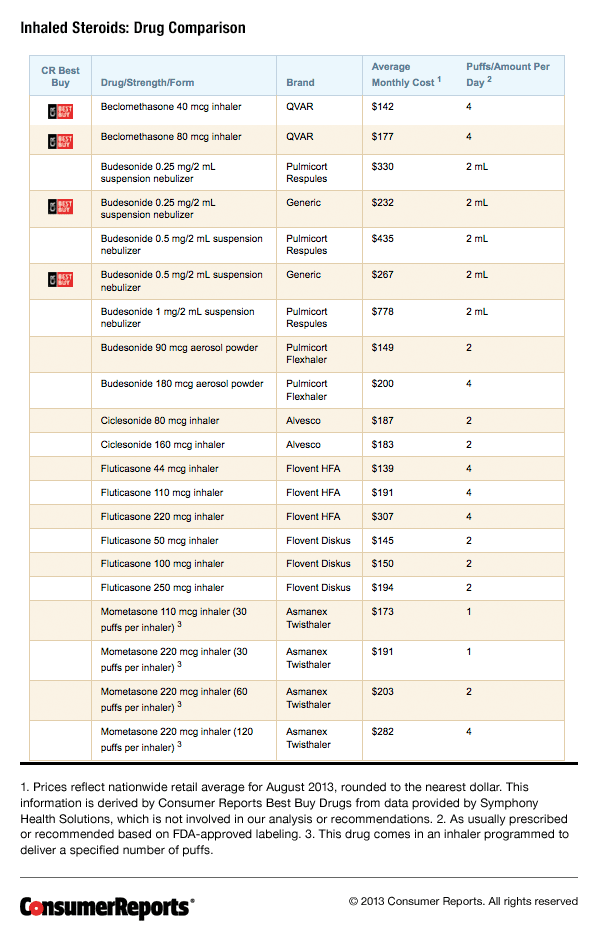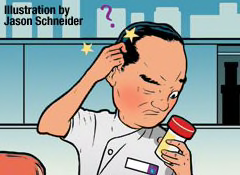1. Adams N. et al., "Fluticasone versus beclomethasone or budesonide for chronic asthma," (Cochrane Review). The Cochrane Library 2004;1.
2. Alsaeedi A. et al. "The effects of inhaled corticosteroids in chronic obstructive pulmonary disease: a systematic review of randomized placebo-controlled trials." Am J Med 2002;113(1):59-65.
3. Banov C. et al., "Budesonide turbuhaler delivered once daily improves health-related quality of life in adult patients with non-steroid-dependent asthma." Allergy Asthma Proc 2003;24(2):129-36.
4. Barnes N.C., et al., "A comparison of fluticasone propionate, 1 mg daily, with beclomethasone dipropionate, 2 mg daily, in the treatment of severe asthma. International Study Group." Eur Respir J 1993;6(6):877-85.
5. Bousquet J. et al., Comparison of the efficacy and safety of mometasone furoate dry powder inhaler to budesonide Turbuhaler." Eur Respir J 2000;16(5):808-16.
6. Burge P.S. et al., "Randomised, double blind, placebo controlled study of fluticasone propionate in patients with moderate to severe chronic obstructive pulmonary disease: the ISOLDE trial." BMJ 2000;320(7245):1297-1303.
7. Calverley P.M. et al., "Maintenance therapy with budesonide and formoterol in chronic obstructive pulmonary disease." Eur Respir J 2003;22(6):912-9.
8. Calverley P. et al., "Combined salmeterol and fluticasone in the treatment of chronic obstructive pulmonary disease: a randomised controlled trial." Lancet 2003;361(9356):449-56.
9. Calverley P.M. et al., "Withdrawal from treatment as an outcome in the ISOLDE study of COPD." Chest 2003;124(4):1350-6.
10. Chervinsky P. Comparison of mometasone furoate administered by metered dose inhaler with beclomethasone dipropionate." Int J Clin Pract 2002;56(6):419-25.
11. Corren J. et al., "Comparison of once-daily mometasone furoate versus once-daily budesonide in patients with moderate persistent asthma." Int J Clin Pract 2003;57(7):567-72.
12. Fabbri L. et al., "Comparison of fluticasone propionate with beclomethasone dipropionate in moderate to severe asthma treated for one year." International Study Group. Thorax 1993;48(8):817-23.
13. Fairfax A. et al., "A randomized, double-blind comparison of beclomethasone dipropionate extrafine aerosol and fluticasone propionate." Ann Allergy Asthma Immunol 2001;86(5):575-82.
14. Fan V.S. et al., "Inhaled corticosteroids in chronic obstructive pulmonary disease and risk of death and hospitalization: time-dependent analysis." Am J Respir Crit Care Med 2003;168(12):1488-94.
15. Hansel TT, Benezet O, Kafe H, et al. A multinational, 12-week, randomized study comparing the efficacy and tolerability of ciclesonide and budesonide in patients with asthma. Clin Ther. Jun 2006;28(6):906-920.
16. Heinig J.H. et al., "The effect of high-dose fluticasone propionate and budesonide on lung function and asthma exacerbations in patients with severe asthma." Respir Med 1999;93(9):613-20.
17. Hoekx J.C. et al., "Fluticasone propionate compared with budesonide: a double-blind trial in asthmatic children using powder devices at a dosage of 400 microg x day(-1)." Eur Respir J 1996;9(11):2263-72.
18. Hubbard R.B., et al., "Inhaled corticosteroids and hip fracture: a population-based case-control study." Am J Respir Crit Care Med 2002;166(12 Pt 1):1563-6.
19. Jones A. et al., "Inhaled corticosteroid effects on bone metabolism in asthma and mild chronic obstructive pulmonary disease." Cochrane Database Syst Rev 2004(1):CD003537.
20. Juniper E.F, et al., "Health-related quality of life in moderate asthma: 400 microg hydrofluoroalkane beclomethasone dipropionate vs 800 microg chlorofluorocarbon beclomethasone dipropionate." The Study Group. Chest 1999;116(5):1297-303.
21. Lee T.A. et al., "Fracture risk associated with inhaled corticosteroid use in chronic obstructive pulmonary disease." Am J Respir Crit Care Med 2004;169(7):855-9.
22. Mahajan P. et al., Impact of fluticasone propionate powder on health-related quality of life in patients with moderate asthma." J Asthma 1997;34(3):227-34.
23. Mahajan P. et al., "The effect of fluticasone propionate on functional status and sleep in children with asthma and on the quality of life of their parents." J Allergy Clin Immunol 1998;102(1):19-23.
24. Medici T.C. et al., "Effect of one year treatment with inhaled fluticasone propionate or beclomethasone dipropionate on bone density and bone metabolism: a randomised parallel group study in adult asthmatic subjects." Thorax 2000;55(5):375-82.
25. Nathan R.A. et al., "Mometasone furoate: efficacy and safety in moderate asthma compared with beclomethasone dipropionate." Ann Allergy Asthma Immunol 2001;86(2):203-10.
26. Newhouse M. et al. "Comparison of efficacy and safety between flunisolide/AeroChamber and budesonide/turbuhaler in patients with moderate asthma." AER-MD-04 Study Group. Ann Allergy Asthma Immunol 2000;84(3):313-9.
27. Paggiaro P.L. et al. "Multicentre randomised placebo-controlled trial of inhaled fluticasone propionate in patients with chronic obstructive pulmonary disease." International COPD Study Group. Lancet 1998;351(9105):773-80.
28. Pauwels R.A. et al., Long-term treatment with inhaled budesonide in persons with mild chronic obstructive pulmonary disease who continue smoking." European Respiratory Society Study on Chronic Obstructive Pulmonary Disease. N Engl J Med 1999;340(25):1948-53.
29. Raphael G.D., et al., "A comparison of multiple doses of fluticasone propionate and beclomethasone dipropionate in subjects with persistent asthma." J Allergy Clin Immunol 1999;103(5 Pt 1):796-803.
30. Ringdal N. et al., "A blinded comparison of fluticasone propionate with budesonide via powder devices in adult patients with moderate to severe asthma: a clinical evaluation." Mediators Inflamm 1996;5:382-89.
31. Sharek P.J. et al., "Beclomethasone for asthma in children: effects on linear growth" (Cochrane Review). The Cochrane Library 2004;1.
32. Simons F.E. "A comparison of beclomethasone, salmeterol, and placebo in children with asthma. Canadian Beclomethasone Dipropionate-Salmeterol Xinafoate Study Group." N Engl J Med 1997;337(23):1659-65.
33. Sin D.D. et al., "Inhaled corticosteroids and the risk of mortality and readmission in elderly patients with chronic obstructive pulmonary disease." Am J Respir Crit Care Med 2001;164(4):580-4.
34. Suissa S. et al. "Low-dose inhaled corticosteroids and the prevention of death from asthma." N Engl J Med 2000;343(5):332-6.
35. Sutherland E.R. et al., "Inhaled corticosteroids reduce the progression of airflow limitation in chronic obstructive pulmonary disease: A meta-analysis." Thorax 2003;58(11):937-941.
36. Szafranski W. et al., "Efficacy and safety of budesonide/formoterol in the management of chronic obstructive pulmonary disease." Eur Respir J 2003;21(1):74-81.
37. Terzano C. et al. "Beclomethasone dipropionate versus budesonide inhalation suspension in children with mild to moderate persistent asthma." Eur Rev Med Pharmacol Sci 2000;4:17-24.
38. Van der Valk P. et al., "Effect of discontinuation of inhaled corticosteroids inpatients with chronic obstructive pulmonary disease: the COPE study." Am J Respir Crit Care Med 2002;166(10):1358-63.
39. Van Grunsven P. et al., "Short- and long-term efficacy of fluticasone propionate in subjects with early signs and symptoms of chronic obstructive pulmonary disease. Results of the DIMCA study." Respir Med 2003;97(12):1303-12.
40. Van Staa T.P. et al., "Use of inhaled corticosteroids and risk of fractures." J Bone Miner Res 2001;16(3):581-8.
41. Vermeulen JH, Gyurkovits K, Rauer H, Engelstatter R. Randomized comparison of the efficacy and safety of ciclesonide and budesonide in adolescents with severe asthma. Respir Med. Oct 2007;101(10):2182-2191.
42. Vestbo J. et al., "Long-term effect of inhaled budesonide in mild and moderate chronic obstructive pulmonary disease: a randomised controlled trial." Lancet 1999;353(9167):1819-23.
43. von Berg A, Engelstatter R, Minic P, et al. Comparison of the efficacy and safety of ciclesonide 160 microg once daily vs. budesonide 400 microg once daily in children with asthma. Pediatr Allergy Immunol. Aug 2007;18(5):391-400.






























